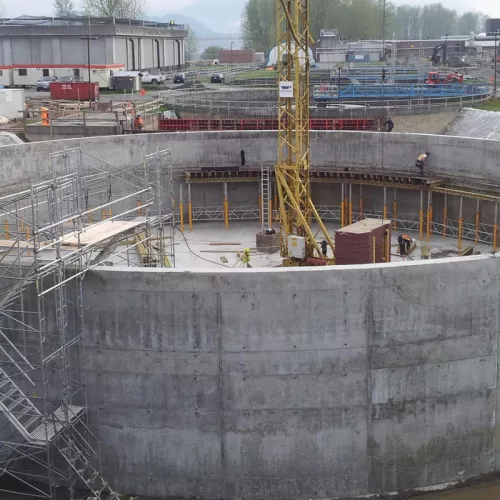
Annacis Island Wastewater Treatment Plant
- Client
- Metro Vancouver
- Sector
- Water treatment
- Delivery mode
- Lump Sum
- Location
- Annacis Island, BC, CA
- Year built
- 2024

Project description
The Annacis Island WWTP Outfall project included the construction of two shafts, two tunnels, two diffuser pipeline sections, a new level control structure with new gates with mechanical, instrumentation, and electrical systems at the effluent end of the existing wastewater treatment plant. After a study of several factors including the geology and hydrology of the site, the expected wear, the depth, the pros and cons of the different excavation methods, as well as the launch and placement of the two tunnels, a pressurized-mud tunnel boring machine was selected for this project. The imposing machine stood with a diameter greater than five metres and was a central part of the construction of the new outfall system for the wastewater treatment plant at Annacis Island, a largely industrial island located in the Fraser River delta, southeast of Vancouver.
Innovations
Construction of the tunnel boring machine (TBM) launching shafts involved extensive risk mitigation reviews to ensure that the built infrastructure would be able to safely support tunneling activities. Extensive design reviews were conducted throughout the works. An example of a mitigation approach involved creating a watertight plug at the base of the slurry wall shafts. The project team had to ensure that the base of the wall protruded well into the clay level of the soil, creating a watertight seal.
We created a well-point to test for water seepage through the site and depending on the results of the well-point test, were able to determine if water infiltrated through the wall or under it . Our allowable seepage was 5m3/hour within the slurry walls. Well-point tests were performed after the placement of the slurry walls and before excavation and, fortunately, we did not run into any instances where seepage was above this limit.
When the TBM encountered an obstruction and was stuck approximately two meters away from the destination, Pomerleau worked with the Metro Vancouver and the Department of Fisheries and Oceans (DFO) to obtain approval to drill pipes from the surface into the riverbed, where the team injected liquid nitrogen to bring the ground/unstable river mud’s temperature to -51C. Barges were used to refill the two nitrogen tanks daily. Site workers then excavated the ground by hand using power tools. This work, started in January 2023, included removal of the obstruction in May 2023, and allowed for completion of the mining by the end of July 2023.
Annacis Island Wastewater Treatment Plant - Dome Removal by Pomerleau
©Metro Vancouver - Al rights reserved
Expertise
Pomerleau tapped into formwork expertise and wastewater knowledge gained in previous projects, and a deep understanding of marine works. These proved advantageous on this project, given the amount of in-water construction that was required.
Environmental considerations
Pomerleau’s Environmental Protection Plan (EPP) for the Annacis Island WWTP Outfall was produced specifically for Metro Vancouver and stemmed from a commitment to prevent pollution and respect the integrity of surrounding ecosystems, resources, and communities. The document described broad mitigation measures, legal compliance practices, and an environmental project management process based on continuous improvement.
One environmental challenge involved in-water construction works. In collaboration with Metro Vancouver, the construction team requested permission from the DFO to extend the timeframe for conducting in-water construction works so that an in-water riser could be delivered in time to facilitate successive works. Approval was granted, allowing construction works to continue throughout restricted fisheries windows. As a condition of the approval, the project team had to implement environmental mitigation measures to ensure works would not affect the spawning routine of the fish. Throughout all conversations with DFO, Pomerleau included Metro Vancouver to ensure that all parties were kept up to date and satisfied with the agreed upon approach.
Our challenges
Because the construction site was near operational facilities, Pomerleau had to ensure their protection. During any work causing vibrations (such as pile driving), Pomerleau installed vibration monitors to ensure that existing structures were not damaged. In addition, settlement monitor points were established on the site and on all existing buildings to ensure no structural impact on existing facilities. A surveyor was assigned to conduct asset monitoring on a full-time basis.
Marine traffic management around the site was a major concern as the Fraser River sees a large volume of daily traffic. Monthly marine user group meetings were held to maintain open communication with all river users and communicate upcoming works. Pomerleau relied on Navigational Warnings and Notices (NAVWARNs) in the monitoring area for current navigational warnings, notices to shipping, notices to mariners, shoals, and status of aids to navigation. In collaboration with Metro Vancouver, the team developed a marine-specific traffic management plan that accounted for the movement of marine traffic and the local environment.
Project Recognition
This large-scale project is not only distinguished by its technical achievements: it has been named Canadian Project of the Year 2025 by the Tunneling Association of Canada. This distinction highlights the innovation, seismic resilience, and sustainability of the solution implemented to modernize the infrastructure and protect the environment.


